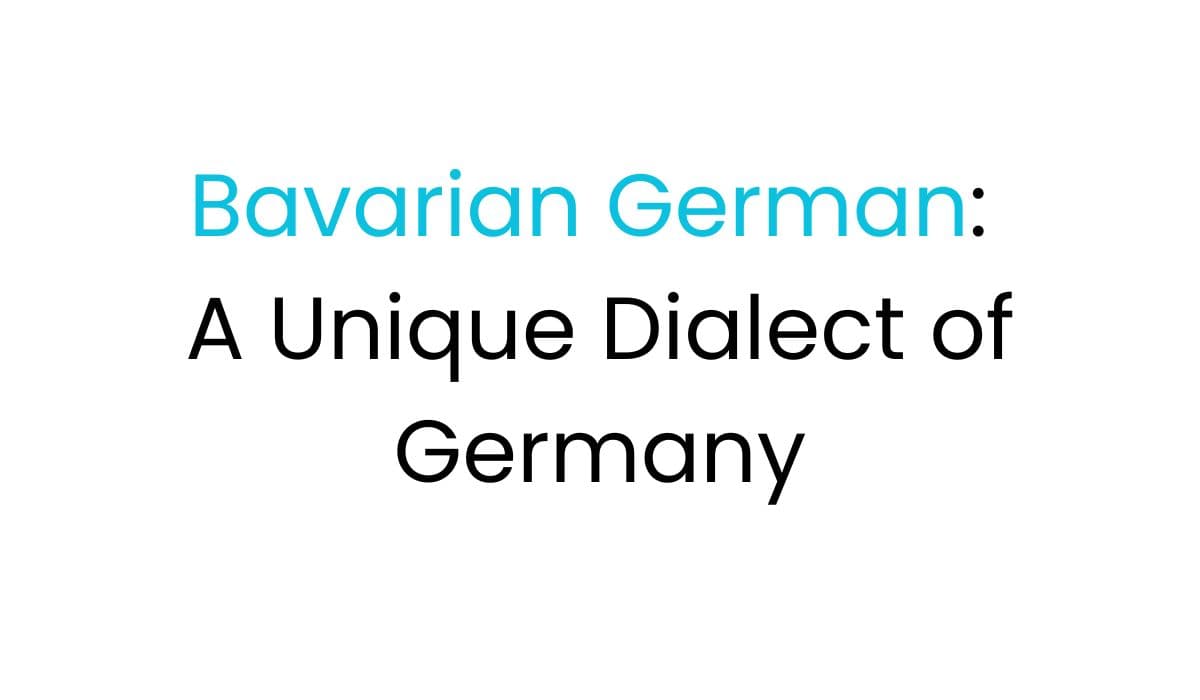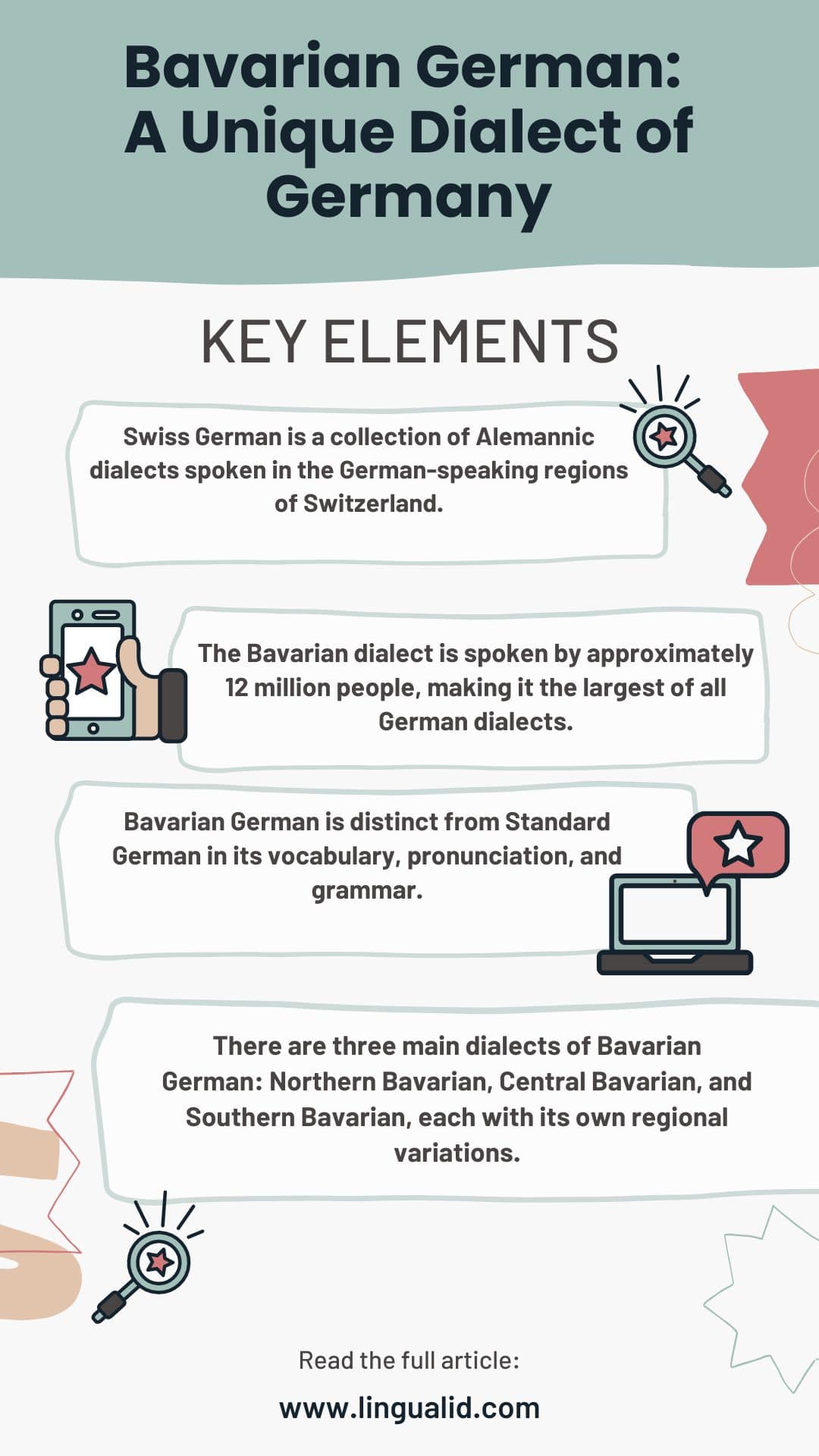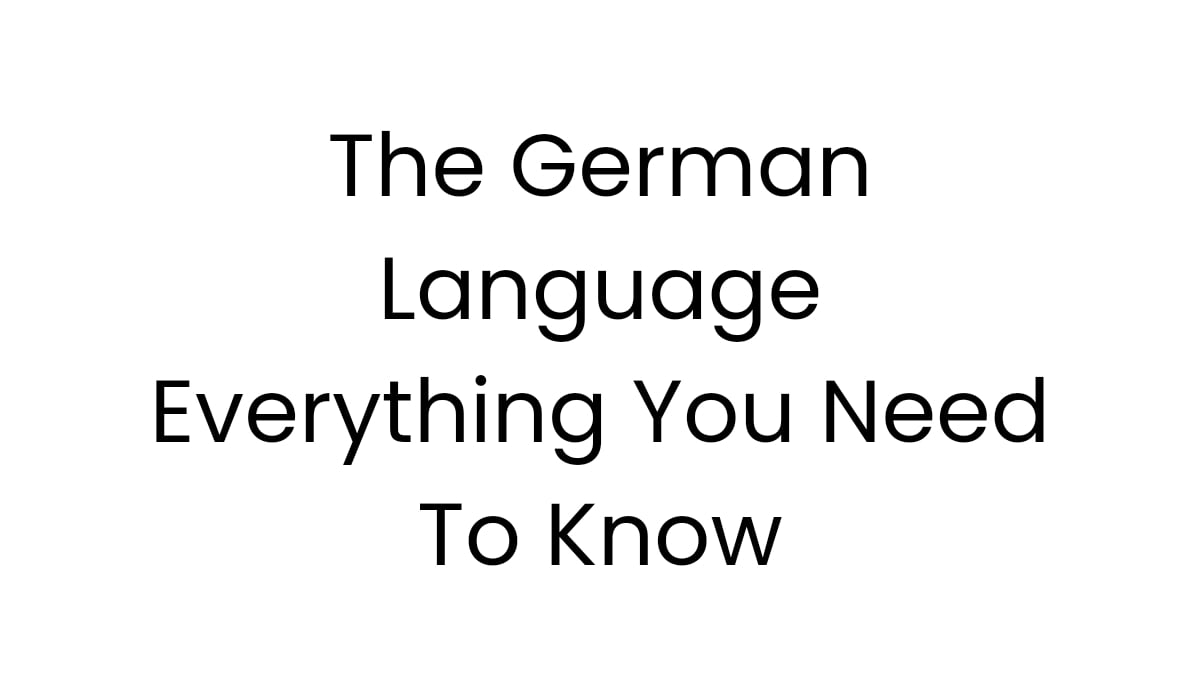Bavarian German, also known as Bairisch or Boarisch, is a key Upper German dialect. It’s mainly spoken in the German state of Bavaria, most of Austria, and the Italian region of South Tyrol. Before 1945, it was also found in parts of the Sudetenland and western Hungary.
This dialect is different from Standard German in many ways. It has its own vocabulary, pronunciation, and grammar. Around 12 million people speak it across 125,000 square kilometers, making it the biggest German dialect.

The history and culture of Bavarian German are rich and deep. It started with the Celtic people who lived there and the German settlers who came later in the early medieval times. Over the years, it has developed unique regional variations and dialects. These are closely linked to the geography of where it’s spoken.
Key Takeaways
- Bavarian German is a major group of Upper German dialects spoken primarily in southern Germany, Austria, and parts of Italy.
- The Bavarian dialect is spoken by approximately 12 million people, making it the largest of all German dialects.
- Bavarian German is distinct from Standard German in its vocabulary, pronunciation, and grammar.
- There are three main dialects of Bavarian German: Northern Bavarian, Central Bavarian, and Southern Bavarian, each with its own regional variations.
- Bavarian German is classified as “Vulnerable” by the UNESCO Atlas of the World’s Languages in Danger, and efforts have been made to preserve and revitalize the language.
- Key Takeaways
- Northern Bavarian
- Central Bavarian
- Southern Bavarian
- Grammars, Vocabularies, and the Bible
- Regional Literature and Pop Songs
- What is Bavarian German?
- What is the origin of the term "Bavarian"?
- Where is Bavarian German spoken?
- What are the main dialects of Bavarian German?
- Is Bavarian German considered a dialect or a separate language?
- How does Bavarian German differ from Standard German?
- How is Bavarian German used in literature and media?
- What efforts are being made to preserve and revitalize Bavarian German?
Introduction
Bavarian German, also known as Bairisch or Boarisch, is a key Upper German dialect. It’s mainly spoken in southern Germany, Austria, and parts of Italy. This dialect is quite different from Standard German in vocabulary, pronunciation, and grammar.
This language has a deep history and is culturally significant. It has around 14 million speakers in southern regions. There are three main dialects: Northern Bavarian, Central Bavarian, and Southern Bavarian. Each has its own special features.
Even though Standard German is used more in formal settings, Bavarian German is still common in everyday life. It’s especially used in smaller towns and communities. Young people from strong Bavarian backgrounds might even speak German with a Bavarian accent.
| Dialect | Region | Distinguishing Features |
|---|---|---|
| Northern Bavarian | Northern Bavaria | Approximately a dozen distinguishable vowel sounds, with variations in nasality, tenseness, and length |
| Central Bavarian | Central Bavaria, parts of Austria | Differences in noun cases and declension patterns compared to Standard German |
| Southern Bavarian | Southern Bavaria, parts of Austria and Italy | Unique verbal mood called the optative, conveying hopes or wishes regarding an action |
Despite its unique features, Bavarian German is often seen as a language, not just a dialect of German. This debate highlights the special cultural and linguistic identity of this regional dialect.
Origins and History
The term “Bavarian” comes from the history and culture of the region. It is linked to the people who lived in Bavaria and their unique language. The name goes back to the Celtic people, the Bojer, who first lived there.
Over time, the name “Bavarian” was given to the mix of Celts, Romans, and Germans who came later. This mix has made the Bavarian dialect what it is today.
- The area was part of the Roman Empire as provinces of Raetia and Noricum, showing Roman influence.
- The name “Bavarian” comes from the Celtic Boii, first mentioned around 520 AD.
- Bavarian law was made between 739-748 AD, influenced by Frankish law. The Agilolfing family ruled the duchy, with the duke chosen by the people and confirmed by the Frankish king.
- Christianity grew in Bavaria in the 8th century. Bishop Rupert started monasteries, and Saint Boniface organized the church there.
The Bavarian German language has changed over time. It was influenced by the Celts, Romans, Franks, and Germans. This mix has made the language and culture unique.
Geographical Distribution
Bavarian German is a special type of German spoken mainly in southern Germany, Austria, and Italy. It’s most common in the German state of Bavaria, which is the biggest state and covers 70,550 square kilometers (27,240 square miles).
In Austria, Bavarian German is spoken in many Alpine areas. It’s also found in the Italian province of South Tyrol, where German has been spoken for a long time. Before 1945, it was also spoken in parts of the Sudetenland (now in the Czech Republic) and western Hungary.
About 12 million people speak Bavarian German over an area of 125,000 square kilometers. This shows the deep historical and cultural links between Bavaria, Austria, and the nearby areas.
| Region | Percentage of Bavarian German Speakers |
|---|---|
| Germany (Bavaria) | Approximately 78.3% |
| Austria | Approximately 8.4% |
| Italy (South Tyrol) | Approximately 0.4% |
| Other European countries | Approximately 7.3% |
Bavarian German is spoken widely in these areas. This shows its big role and impact in the German-speaking world.
Dialects and Variations
Bavarian German is a distinct dialect spoken in southern Germany, Austria, and parts of Italy. It’s not just one language but has three main dialects. Each has its own special features and is tied to certain states or regions.
Northern Bavarian
Northern Bavarian is spoken in the north of Bavaria, in Upper Palatinate and Upper Franconia. It’s known for its unique vowel sounds, like “oa” instead of “au.” It also simplifies grammar, making it easier to understand.
Central Bavarian
Central Bavarian is the most common Bavarian dialect, found in central Bavaria and Austria. It varies a lot, with differences between the east and west. For example, accents in Carinthia, Styria, and Tyrol sound quite different from each other.
Southern Bavarian
Southern Bavarian is spoken in the south of Bavaria, Austria, and South Tyrol, Italy. It has its own special words, like “Semmel” for a bread roll, “Radi” for radish, and “Knedl” for dumplings. The way people say words in Southern Bavarian is also quite different from Standard German.
| Dialect | Regions | Distinctive Features |
|---|---|---|
| Northern Bavarian | Upper Palatinate, Upper Franconia | Distinctive vowel sounds, simplified grammar |
| Central Bavarian | Central Bavaria, Austria | Diverse variations, including distinct accents in Carinthia, Styria, and Tyrol |
| Southern Bavarian | Southern Bavaria, Austria, South Tyrol | Unique vocabulary, distinct pronunciation with variations in vowels and consonants |
The variety in Bavarian German shows the rich culture of the region. Each dialect has grown over time, shaped by the history and influences of its area.
Bavarian German: A Language or Dialect?
Many experts have debated whether Bavarian German is a language or a dialect. Some say it’s a dialect of German, while others believe it’s a language because of its unique features.
The debate was fueled when the International Organization for Standardization (ISO) gave Bavarian German its own ISO 639-3 code, “bar”. This code shows that Bavarian German is seen as a language, not just a German dialect.
- Bavarian dialects are spoken in many places, like Altbayern, Austria, and parts of Italy and the Czech Republic.
- These dialects stand out with their own way of speaking and words.
- There are three main types of Bavarian dialects: Southern, Central, and Northern.
But, some experts say Bavarian German shouldn’t be called a language. They think it’s too similar to Standard German. They believe it’s a regional dialect with its own special traits.
“In a survey by the Institut für Demoskopie Allensbach, 72% of people in Bavaria said they speak a dialect. This is the highest rate in Germany. Also, 81% of those in Altbayern use dialect, showing its widespread use.”
The question of whether Bavarian German is a language or a dialect is still up in the air. Both sides have strong points. The history, variety, and cultural importance of Bavarian German make it an interesting part of German language, no matter what it’s called.
Vocabulary and Expressions
Bavarian German is a special dialect spoken in southern Germany, Austria, and parts of Italy. It has its own words and sayings that are different from Standard German. These differences show the unique culture and traditions of the Bavarian people.
A “Semmel” in Bavarian means a bread roll, not like Standard German’s “Brötchen.” “Radi” is the word for radish, not “Rettich” in Standard German. Also, “Knedl” is used for dumplings, not “Knödel” or “Klöße” in Standard German.
These unique words and expressions make Bavarian German rich and interesting. They show the special cultural identity of the Bavarians. They also add to the variety of German languages.
| Bavarian German | Standard German | English Translation |
|---|---|---|
| Semmel | Brötchen | Bread roll |
| Radi | Rettich | Radish |
| Knedl | Knödel/Klöße | Dumplings |
Bavarian German has not just unique words but also special expressions. These expressions often mean different things or have different feelings than in Standard German. This adds to the German language’s richness and shows the cultural heritage of Bavaria.
Pronunciation and Grammar
The Bavarian German dialect stands out with its unique pronunciation and simpler grammar. It has different vowel and consonant sounds than Standard German. This makes it distinct.
In Bavarian German, the sound /h/ can be [ç], [x], or [h]. This is different from Standard German, which usually says [h]. Also, Bavarian German often uses articles and prepositions in simpler ways.
| Feature | Standard German | Bavarian German |
|---|---|---|
| Vowel Sounds | More uniform vowel pronunciations | Greater variation in vowel sounds |
| Consonant Sounds | Consistent use of [h] | Realization of /h/ as [ç], [x], or [h] |
| Articles | Strict use of definite and indefinite articles | Simplified or omitted use of articles |
| Prepositions | Adherence to standard preposition usage | Simplified or altered preposition usage |
The unique Bavarian German pronunciation and grammar make it stand out. It has simpler grammatical structures. For example, it often uses fewer articles and prepositions. This is what makes this regional dialect special.
Bavarian German in Literature and Media
Bavarian German is mainly spoken but also appears in literature and media. Its unique words, sounds, and rules have been studied and even translated into a Bible. This shows how special the dialect is.
Writers and poets use Bavarian German to show what the region is like. In the 1970s and 1980s, a music trend called Austropop made the language popular in songs. This shows how Bavarian German can be more than just a way to talk.
Grammars, Vocabularies, and the Bible
Even though it’s mostly spoken, Bavarian German has been studied in detail. Grammars and vocabularies help keep its special features alive. There’s even a Bible in Bavarian German, proving the language’s wide use.
Regional Literature and Pop Songs
In regional literature, Bavarian German is a big deal. Authors and poets use it to bring the region to life. The Austropop music of the 1970s and 1980s made Bavarian German even more popular. Many songs from that time used its unique sounds and words.
| Bavarian German in Literature and Media | Examples |
|---|---|
| Grammars and Vocabularies | Various linguistic resources dedicated to preserving the intricacies of the Bavarian German dialect |
| Bible Translation | A translation of the Bible into the Bavarian German dialect |
| Regional Literature | Works by authors and poets who incorporate Bavarian German to capture the essence of the region |
| Pop Songs | Austropop music from the 1970s and 1980s that features Bavarian German expressions and rhythms |
Language Preservation and Revitalization
Bavarian German, a unique dialect of German, faces challenges in being preserved and revitalized. The UNESCO Atlas of the World’s Languages in Danger labels it as “Vulnerable.” This means we need to work hard to keep it alive and vibrant.
A big step forward has been the Bavarian Wikipedia. This online encyclopedia is all in Bavarian. It helps keep the language’s special words, grammar, and sayings alive. Also, some websites in Bavarian make the language more visible and easy to reach online.
Language preservation and revitalization is happening worldwide. Languages like Te Reo Māori in New Zealand and Nam Trik in the Colombian Andes are at risk. Factors like the spread of bigger languages, laws, and globalization threaten them.
In Bavaria and Austria, local communities are leading the charge to save Bavarian German. They know how crucial it is to keep their language and culture alive. The UNESCO Atlas shows us that Bavarian German is “Vulnerable.” This means we must keep working hard to make sure it survives and thrives.
| Language | Region | Status | Speakers |
|---|---|---|---|
| Te Reo Māori | New Zealand | At risk of extinction by 2100 | Approximately 157,000 speakers |
| Nam Trik | Colombian Andes | Few thousand speakers, at risk of disappearing within this lifetime | Fewer than 10,000 speakers |
| Yiddish | Jewish communities | Declined due to the Holocaust, efforts to revive ongoing | Approximately 1 million speakers worldwide |
| Icelandic | Iceland | Under threat due to English influence, incorporating English words; efforts to preserve ongoing | Approximately 360,000 speakers |
| Bavarian German | Germany, Austria, Italy | Classified as “Vulnerable” by UNESCO | Spoken by approximately 6 million people in Bavaria |
Bavarian German
Bavarian German, also known as Bairisch or Boarisch, is a unique dialect spoken in southern Germany, Austria, and parts of Italy. It has a rich history and diverse dialects, making it a key part of German language culture. The dialect’s vocabulary, pronunciation, and grammar are different from Standard German. They reflect the traditions and identity of the Bavarian people.
The Bavarian people brought this dialect to the region centuries ago. Over time, it was shaped by languages like Celtic, Roman, and Germanic. Today, it’s a big part of the Bavarian cultural identity. The people of Bavaria are proud of their language heritage.
There are three main dialects of Bavarian German: Northern, Central, and Southern. Each has its own special features. For example, Northern Bavarian is known for its softer sounds. Southern Bavarian has more guttural and emphatic sounds.
| Characteristic | Northern Bavarian | Central Bavarian | Southern Bavarian |
|---|---|---|---|
| Pronunciation | Softer | Moderate | More guttural and emphatic |
| Vocabulary | Influenced by Franconian dialects | Typical Bavarian words | Incorporates more Italian and Austrian influences |
| Grammatical Structures | Simplifies some Standard German structures | Maintains more Standard German features | Exhibits greater grammatical variations |
All Bavarian German dialects share a deep cultural heritage and connection to the Bavarian identity. They are linked to traditional Bavarian food, festivals, clothing, and architecture. This dialect is a big part of the region’s lively culture.
Bavarian German is a fascinating part of the German language. It interests linguists, historians, and locals. Its ongoing preservation shows the spirit and pride of the Bavarian people.

Conclusion
Bavarian German is a special dialect with a deep history and cultural importance. It’s a key part of the language in southern Germany, Austria, and parts of Italy. It started from Celtic and Roman roots and grew with the Bavarian people. This dialect has kept its own identity, even as it was shaped by the wider German language.
There are efforts to keep Bavarian German alive, but it still faces big challenges. Standard German is often used more in schools, media, and official places. Yet, Bavarian German is still used in literature, music, and daily talk. This shows the strength and pride of those who keep this language alive.
We’ve seen that Bavarian German is more than just a local way of speaking. It’s a complex part of the German language that shows the cultural variety and identity of the region’s people. By valuing and understanding Bavarian German, we can see how rich and complex the German language is.
FAQ
What is Bavarian German?
Bavarian German, also known as Bairisch or Boarisch, is a type of Upper German dialect. It’s mainly spoken in Bavaria, Austria, and South Tyrol, Italy.
What is the origin of the term “Bavarian”?
The name “Bavarian” comes from the people who first settled in Bavaria. The word’s origin is a bit unclear, but it likely comes from “Bajowarjōz,” meaning “people of Bojer land.”
Where is Bavarian German spoken?
You can find Bavarian German in Bavaria, Austria, and South Tyrol, Italy. Before 1945, it was also spoken in parts of the Sudetenland and western Hungary.
What are the main dialects of Bavarian German?
There are three main dialects: Northern Bavarian, Central Bavarian, and Southern Bavarian. Each has its own unique features, often tied to specific states or regions.
Is Bavarian German considered a dialect or a separate language?
Some see Bavarian German as a German dialect, while others consider it a separate language. It has its own ISO 639-3 code, showing its unique status.
How does Bavarian German differ from Standard German?
Bavarian German uses many unique words and expressions not found in Standard German. Its pronunciation also varies more in vowels and consonants.
How is Bavarian German used in literature and media?
Bavarian German is mainly spoken, but it’s also in books, poetry, and music. It’s especially popular in the Austropop of the 1970s and 1980s.
What efforts are being made to preserve and revitalize Bavarian German?
There are efforts to keep Bavarian German alive, as it’s seen as “Vulnerable” by UNESCO. These include a Bavarian Wikipedia and websites in the dialect.
Oualid Cheddadi is the founder of Lingualid, a platform that inspires independent language learners worldwide, regardless of the language they are learning. The name “Lingualid” is derived from the Portuguese word for “language,” “língua,” and the last three letters of Oualid’s name, “Lid.”



